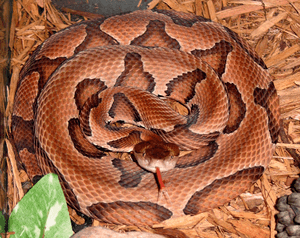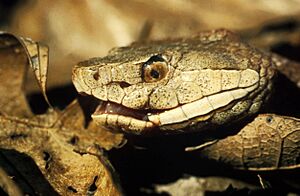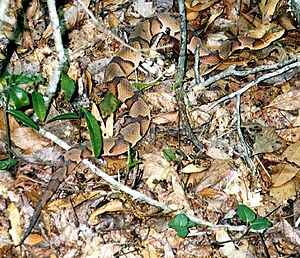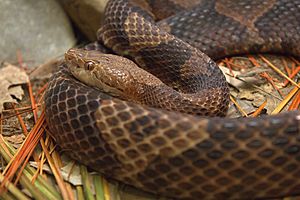Agkistrodon contortrix facts for kids
The copperhead (scientific name: Agkistrodon contortrix) is a type of venomous snake. It lives only in Eastern North America. This snake belongs to a group called pit vipers. Copperheads sometimes come across humans because of how they behave.
Contents
What Does a Copperhead Look Like?
Adult copperheads have a head and neck that are a coppery color. They are not very big snakes. Most are about 50 centimeters (1.5 feet) long. Some can grow up to 1 meter (3 feet) long. Their bodies are quite thin compared to other pit vipers. The head is wide and stands out from the neck.
Other Names for Copperheads
People call A. contortrix by many names. These include: copperhead (snake), chunk head, highland moccasin, (dry-land) moccasin, narrow-banded copperhead, northern copperhead, pilot snake, poplar leaf, red oak, red snake, southeastern copperhead, white oak snake, American copperhead, southern copperhead, and cantil cobrizo (Spanish).
Where Do Copperheads Live?
Copperheads live in many parts of the United States. You can find them in states like Alabama, Arkansas, Connecticut, Delaware, northern Florida, Georgia, Illinois, Indiana, Iowa, Kansas, Kentucky, Louisiana, Ohio, Oklahoma, Maryland, Massachusetts, Mississippi, Missouri, Nebraska, New Jersey, New York, North Carolina, Pennsylvania, South Carolina, Tennessee, eastern Texas, Virginia, and West Virginia. They also live in Mexico, in the states of Chihuahua and Coahuila.
These snakes live in many different places. In most of North America, they like forests with trees that lose their leaves. They are often found near rocks and ledges. But they can also live in low, wet areas like swamps. In winter, they sleep in dens, often with other snakes like timber rattlesnakes. In states near the Gulf of Mexico, they can also be found in pine forests. In the Chihuahuan Desert, they live near water, like rivers or dry streambeds.
Are Copperheads in Danger?
The IUCN says that copperheads are a species of "Least Concern." This means they are not currently threatened. They are found in many places and have a large population. Their numbers were stable when checked in 2015.
How Do Copperheads Behave?
Like all pit vipers, copperheads usually wait for their food. They find a good spot and hide, waiting for prey to come by. But sometimes, they will actively hunt insects like caterpillars or cicadas. Young copperheads have a bright tail tip. They wiggle this tail to attract frogs and lizards. In the southern U.S., they are active at night during hot summers. In spring and fall, they are often active during the day.
Copperheads usually try to avoid people. If they can, they will slither away. But unlike other snakes, they often "freeze" (stay very still) instead of moving. This is why many people get bitten. They step on or near a copperhead without seeing it. Their camouflage works very well. When they are on dead leaves or red dirt, they are almost impossible to spot. They will often stay still even when someone gets close. They usually only strike if someone touches them or steps on them.
Like many other vipers, copperheads will shake their tails if they feel threatened. They can shake their tails very fast, over 40 times a second! If you touch a copperhead, it might release a musky smell that some people say smells like cucumbers.
What Do Copperheads Eat?
About 90% of a copperhead's diet is small rodents, like mice and voles. They also like to eat large insects and frogs. Even though they mostly stay on the ground, they have been seen climbing trees. They do this to eat cicadas when they come out.
How Do Copperheads Reproduce?
Copperheads usually breed in late summer. But they don't breed every year. A female might have babies for a few years, then take a break. They give birth to live young, not eggs. Each baby snake is about 20 centimeters (8 inches) long. A mother usually has 4 to 7 babies, but can have as few as one or as many as 20. The young snakes look like smaller versions of the adults. They are lighter in color and have a yellow-green tip on their tail. They use this tail to attract lizards and frogs.
Copperhead Venom
Copperheads are venomous, meaning they have venom. But their bites are almost never deadly to humans. They are also generally not aggressive. They have long fangs at the front of their mouth that fold back when they close it. The name Agkistrodon means "fish-hook tooth," referring to their curved fangs. Their venom and fangs are mainly used to quickly kill their food. The amount of venom a copperhead can deliver is usually not enough to kill a healthy adult human.
However, a copperhead bite can cause strong pain, tingling, throbbing, swelling, and severe nausea. While rarely deadly, a bite can damage muscle and bone tissue. This is especially true if the bite is on hands or feet, where there isn't much muscle to absorb the venom. Any bite from a venomous snake should be taken seriously. You should get medical help right away.
Copperheads often give a "warning bite" if they are stepped on or bothered. They might inject only a small amount of venom, or sometimes no venom at all. These "dry bites" (bites with no venom) are common with copperheads. All pit vipers can give a dry bite.
In Missouri, about 200 people are bitten by snakes each year, mostly by copperheads. But no deaths have been recorded there from copperhead bites. There is an antivenom called CroFab that could be used for a copperhead bite. However, doctors usually don't give it. This is because the risk of an allergic reaction to the antivenom can be greater than the risk from the snakebite itself. Instead, doctors usually focus on managing pain, giving antibiotics, and watching for any problems.
Scientists have found a protein in copperhead venom called "contortrostatin." In studies with mice, this protein stopped cancer cells from growing and spreading. But more tests are needed to see if it is safe and works for humans.
Spotting a Copperhead and Staying Safe
Many people think any reddish or brownish snake is a copperhead. But this is not true. Many harmless snakes, like brown snakes or water snakes, are often mistaken for copperheads. Copperheads mostly live on land. While they can swim, you rarely find them in water.
The easiest way to tell if a snake in North America is venomous (except for the coral snake) is by its eye pupils. All venomous snakes in North America are pit vipers and have vertical pupils, like a cat's eye. All non-venomous snakes in North America have round pupils, like a human's.
Staying Safe Around Copperheads
The best way to avoid a bite when outdoors is to know how copperheads behave and where they live. Then you can take steps to be careful. Copperheads usually want to avoid people and will leave if they can. But unlike rattlesnakes, they don't make a sound to warn you.
Copperheads often "freeze" instead of slithering away. This means many bites happen when people accidentally step on or near them. This freezing behavior likely developed because their camouflage works so well. When they are on dead leaves or red clay, they can be almost impossible to see. They will often stay still even when you get close. They usually only strike if they are touched or stepped on.
Always check small hiding places like cracks in rock walls or woodpiles before putting your hands or feet there. If you need to cross a fallen log, step on it or look over it first, instead of just jumping over. Copperheads like rocky hillsides above wooded streams. In the south, they are active at night during hot summer months. But in spring and fall, they are often active during the day. Wearing strong leather hiking boots can help protect your feet from a snake strike. Walking loudly can create vibrations in the ground. This can warn snakes that people are coming, giving them time to get away quietly. Most snakebites happen when people try to handle a snake or attack it.
If someone is bitten, do not use a tourniquet or try to suck the blood from the bite. Keep the person calm and get them to a hospital as quickly as possible. A tourniquet can cause more damage to the bitten area. It might even lead to needing to remove the limb, which could have been saved otherwise. Never cut the bite area.
Types of Copperheads
| Subspecies | Common name | Where it lives |
|---|---|---|
| A. c. contortrix | southern copperhead | The United States, in the lower Mississippi Valley and states near the Gulf of Mexico, from eastern Texas to southern Illinois. Also on the South Atlantic Coastal Plain from the Florida panhandle to South Carolina. |
| A. c. laticinctus | broad-banded copperhead | The United States, from south-central Texas (around Victoria to Frio Counties), north through central Oklahoma to the very south of Cowley County, Kansas. |
| A. c. mokasen | northern copperhead | The United States, in southern Illinois, extreme northeastern Mississippi, northern Alabama, northern Georgia northeast to Massachusetts, and the Appalachian Mountain region. |
| A. c. phaeogaster | Osage copperhead | The United States, in eastern Kansas, extreme southeastern Nebraska, and a large part of Missouri. |
| A. c. pictigaster | Trans-Pecos copperhead | The United States, in western Texas from the Pecos and Devils Rivers to Jeff Davis and Presidio counties. Also in Mexico, in northern Chihuahua and Coahuila. |
Images for kids
See also
 In Spanish: Agkistrodon contortrix para niños
In Spanish: Agkistrodon contortrix para niños












